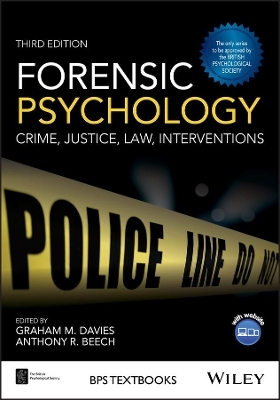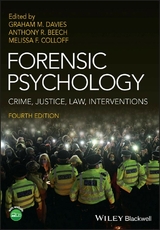
Forensic Psychology
Wiley-Blackwell (Verlag)
978-1-119-10667-8 (ISBN)
- Titel ist leider vergriffen;
keine Neuauflage - Artikel merken
Introduces forensic psychology to students and professionals who want to better understand psychology’s expanding influence on the study of law, crime and criminality
Forensic psychology is a constantly growing discipline, both in terms of student interest and as a profession for graduates. This book highlights the often sizeable gap between media myths surrounding forensic practice and reality. Editors Graham Davies and Anthony Beech present an exciting and broad range of topics within the field, including detailed treatments of the causes of crime, investigative methods, the trial process, and interventions with different types of offenders and offences.
Forensic Psychology: Crime, Justice, Law, Interventions, Third Edition covers every aspect of forensic psychology—from understanding criminal behaviour, to applying psychological theory to criminal investigation, analysing the legal process and the treatment of witnesses and offenders. Each chapter has been thoroughly revised and updated with the latest findings. The book also includes two entirely new chapters—one on psychopathy and crime, the other on female offenders. Drawing on a wealth of experience from leading researchers and practitioners, this new edition will interest and enthuse today’s generation of students.
All chapters thoroughly revised and updated
Features two brand new chapters
Supplemented by additional online resource materials, including related links, multiple choice questions, and PowerPoint slides
Authored by a wide-range of experienced forensic psychology professionals
Forensic Psychology, Third Edition is essential reading for undergraduates’ first encounter with the subject area and is an excellent introduction for more specialised postgraduate courses.
Graham M. Davies is Emeritus Professor of Psychology at the University of Leicester and an Honorary Professor of Forensic Psychology at the Universities of Birmingham and Coventry, UK. His research interests focus on the testimony of children and adults and the support of vulnerable witnesses at court, on which topics he has published 10 books and over 150 articles in scientific journals. He is a Fellow of the British Psychological Society and was the recipient of the Senior Award from the British Psychological Society Division of Forensic Psychology for a significant lifetime contribution to Forensic Psychology in 2012. Anthony R. Beech is an Emeritus Professor of Criminological Psychology at the University of Birmingham, UK. He has authored over 180 peer-reviewed articles, 50 book chapters and eight books in the area of forensic science/criminal justice. He is a Fellow of the British Psychological Society and was the recipient of the Senior Award from the British Psychological Society Division of Forensic Psychology for a significant lifetime contribution to Forensic Psychology in 2009. He also received the Significant Achievement award from the US-based Association for the Treatment of Sexual Abusers (ATSA) in 2009.
Contributors xv
Preface to Third Edition xix
About the Editors xxi
About the Companion Website xxiii
INTRODUCTION
Graham M. Davies, Anthony R. Beech and Clive Hollin 1
Forensic Psychology 3
How to Become a Forensic Psychologist 13
Professional Organisations for Forensic Psychologists 14
Structure and Content of This Book 16
PART 1 The Causes of Crime 23
CHAPTER 1 Psychological Approaches to Understanding Crime 25
Emma J. Palmer
1.1 Introduction 27
1.2 Psychological Theories 27
1.3 Theories, Evidence, and Crime 31
1.4 Mentally Disordered Offenders 39
1.5 Conclusions 46
1.6 Summary 47
CHAPTER 2 Developmental and Psychological Theories of Offending 55
David P. Farrington and Maria M. Ttofi
2.1 Introduction 57
2.2 Developmental Theories 57
2.3 Case Studies From the Cambridge Study in Delinquent Development 63
2.4 Psychological Theories 64
2.5 The ICAP Theory 72
2.6 Conclusions 75
2.7 Summary 76
CHAPTER 3 Psychopathy 83
Steven M. Gillespie and Ian J. Mitchell
3.1 Introduction 85
3.2 Assessment of Psychopathy 86
3.3 Psychopathy and Aggression 90
3.4 Correlates of Psychopathy in Adolescents and Children 91
3.5 Genetic Basis of Psychopathy 92
3.6 Family Factors Associated with the Development of Psychopathy 93
3.7 Attachment, Psychopathy and Offending 93
3.8 Facial Expression Recognition 94
3.9 Psychopathy and Aversive Conditioning 97
3.10 Neurochemistry of Psychopathy 98
3.11 Conclusions 99
3.12 Summary 100
CHAPTER 4 Understanding Risk Factors for Offending: The Contributions of Neuroscience 107
Anthony R. Beech, Benjamin Nordstrom, Adrian Raine and Dawn Fisher
4.1 Introduction 109
4.2 The Development of the Brain 109
4.3 The Social Brain 110
4.4 Risk Factors for Offending 115
4.5 Modifying Environmental Risk Factors 128
4.6 Summary 129
CHAPTER 5 Effects of Interpersonal Crime on Victims 139
Catherine Hamilton-Giachritsis and Emma Sleath
5.1 Introduction 141
5.2 Childhood Victimisation 141
5.3 Adulthood Victimisation 152
5.4 Summary 161
PART 2 Investigating Crime 171
CHAPTER 6 Eyewitness Evidence 173
Harriet M. J. Smith, Hannah Ryder and Heather D. Flowe
6.1 Introduction 175
6.2 The Memory Process 176
6.3 Estimator vs. System Variables 177
6.4 Encoding Factors 177
6.5 Storage Factors 183
6.6 Retrieval Factors 189
6.7 Conclusions 192
6.8 Summary 192
CHAPTER 7 Interviewing Witnesses 201
Allison P. Mugno, Lindsay C. Malloy and David J. La Rooy
7.1 Introduction 203
7.2 Shortcomings and Consequences of Traditional Investigative Interviews 204
7.3 The Cognitive Interview (Ci) 206
7.4 Interviewing Vulnerable Witnesses 211
7.5 Summary 223
CHAPTER 8 Interviewing Suspects 231
Erik Mac Giolla and Pär Anders Granhag
8.1 Introduction 233
8.2 What Officers are Advised to Do 233
8.3 What Officers Do 236
8.4 What Officers Should and Should Not Do 238
8.5 Conclusions 247
8.6 Summary 248
CHAPTER 9 Detecting Deception 255
Pär Anders Granhag and Maria Hartwig
9.1 Introduction 257
9.2 Theoretical Approaches to Deception 257
9.3 Objective Cues to Deception 259
9.4 Lie-Catchers’ Performance 259
9.5 Detecting Deception from Verbal Content 262
9.6 Computer-Based Linguistic Analysis 264
9.7 Psycho-Physiological Detection of Deception 265
9.8 Strategic Interviewing in Order to Elicit and Enhance Cues to Deception 269
9.9 New Directions in Deception Detection Research 273
9.10 Training to Detect Deception 275
9.11 Conclusions 276
9.12 Summary 276
CHAPTER 10 Offender Profiling and Crime Linkage 283
Jessica Woodhams and Matthew Tonkin
10.1 Introduction 285
10.2 Crime Linkage 285
10.3 Offender Profiling 292
10.4 Summary 300
CHAPTER 11 Interpersonal Violence and Stalking 307
Louise Dixon and Erica Bowen
11.1 Introduction 309
11.2 Definitions and Terminology 309
11.3 Lifetime and 12-Month Prevalence Rates of Intimate Partner Violence and Stalking 313
11.4 Risk Factors and Theories 317
11.5 Subtypes of Perpetrators 322
11.6 Implications for Practice: Risk Assessment 326
11.7 Summary 327
CHAPTER 12 Terrorism 335
Max Taylor
12.1 Introduction 337
12.2 What Are Terrorists, and What is Terrorism? 337
12.3 The Psychology of Terrorism 339
12.4 Becoming, Remaining, Disengaging 342
12.5 Radicalisation 348
12.6 Progression into Terrorist Activities: Autobiographical and Biographical Accounts 352
12.7 Disengagement 354
12.8 Suicide Terrorism and Political Suicide 355
12.9 Assessment of Dangerousness 357
12.10 Summary 358
PART 3 The Trial Process 365
CHAPTER 13 Judicial Processes 367
Jacqueline M. Wheatcroft
13.1 Introduction 369
13.2 Understanding the Justice System 369
13.3 Evidence in Court 372
13.4 Judges as Decision-Makers 379
13.5 Juries as Decision-Makers 382
13.6 Conclusions 389
13.7 Summary 390
CHAPTER 14 Safeguarding Vulnerable Witnesses 399
Graham M. Davies and Helen L. Westcott
14.1 Introduction 401
14.2 Witnesses’ Fears and Perceptions about Going to Court 402
14.3 Preparing Witnesses for Court: Preparation and Social Support in Theory and Practice 404
14.4 Protecting Witnesses at Court Through Special Measures 408
14.5 Still Unmet Needs 415
14.6 Conclusions 419
14.7 Summary 420
CHAPTER 15 Identifying Perpetrators 427
Tim Valentine
15.1 Introduction 429
15.2 The Problem of Mistaken Identification 429
15.3 Eyewitness Identification and Human Memory 429
15.4 Design Requirements of Identification Procedures 431
15.5 Estimator Variables 434
15.6 System Variables 439
15.7 Malleability of Witness Confidence 446
15.8 Official Guidance 447
15.9 Identification From CCTV 448
15.10 Conclusions 450
15.11 Summary 451
CHAPTER 16 The Role of the Expert Witness 457
Daniel T. Wilcox and Leam A. Craig
16.1 Introduction 459
16.2 Taking Instruction 459
16.3 Expert in Content and Process 460
16.4 Evidence on Clinical Factors 463
16.5 Standard of Proof 467
16.6 Providing an Expert Opinion 469
16.7 Giving Oral Evidence at Court 471
16.8 Conclusions 475
16.9 Summary 476
PART 4 Dealing with Offenders 479
CHAPTER 17 Crime and Punishment: What Works? 481
James McGuire
17.1 Introduction 483
17.2 The Sentence of the Court 484
17.3 The Objectives of Sentencing 485
17.4 The Impact of Sentencing 490
17.5 Reducing Offending Behaviour 494
17.6 Psychological Contributions to Offender Assessment and Management 504
17.7 Summary 505
CHAPTER 18 Risk Assessment and General Offender Behaviour Programme Delivery 513
Ruth Hatcher
18.1 Introduction 515
18.2 Risk Assessment within Offender Management 516
18.3 Methods of Assessing Risk 518
18.4 Risk and Need Instruments for Offenders 519
18.5 Treatment Delivery 529
18.6 General Offending Behaviour Programmes 530
18.7 Evaluation of General Offending Behaviour Programmes 533
18.8 Issues Related to Offending Behaviour Programmes 534
18.9 Summary 537
CHAPTER 19 Treating Dangerous Offenders 545
Leigh Harkins, Jayson Ware and Ruth Mann
19.1 Introduction 547
19.2 Types of Dangerous Offenders Typically Treated in a Criminal Justice Setting 548
19.3 Treatment Frameworks 552
19.4 The Evidence Base for the Treatment of Dangerous Offenders 564
19.5 Considerations in Working with Dangerous Offenders 567
19.6 Summary 570
CHAPTER 20 Interventions with Female Offenders 579
Franca Cortoni and Nathalie M. G. Fontaine
20.1 Introduction 581
20.2 Antisocial Behaviour in Adolescent Females 581
20.3 Adult Female Offenders 587
20.4 Summary 595
CHAPTER 21 Interventions for Offenders with Intellectual Disabilities 601
William R. Lindsay, John L. Taylor and Amanda M. Michie
21.1 Introduction 603
21.2 The Prevalence of ID in Offender Populations 603
21.3 ID As a Risk Factor for Offending 605
21.4 Assessment of Offenders with ID 605
21.5 Interventions with Offenders with ID 614
21.6 Autism Spectrum Disorders and Crime 626
21.7 Summary 628
CHAPTER 22 Interventions with Mentally Disordered Offenders 637
Dawn Fisher, Michelle Ginty, Jagjit Sandhu and Nuwan Galappathie
22.1 Introduction 639
22.2 History of Forensic Mental Health Services 640
22.3 Types of Mental Illness/Forensic Behaviours Seen in Forensic Mental Health Services 642
22.4 Legislation Pertaining to Mentally Disordered Offenders 650
22.5 The Role of the Psychologist in Forensic Mental Health Settings 653
22.6 Summary 657
CHAPTER 23 The Rehabilitation of Offenders: Good Lives and Risk Reduction 661
Tony Ward and Gwenda M. Willis
23.1 Introduction 663
23.2 What is the Nature of Offender Rehabilitation? 665
23.3 What are the Features of Effective Offender Rehabilitation? 667
23.4 Desistance From Crime 671
23.5 The Risk-Need-Responsivity Model of Offender Rehabilitation 673
23.6 Limitations of the Risk-Need-Responsivity Model 673
23.7 The Good Lives Model 676
23.8 Summary 682
Glossary 689
Index 705
| Erscheinungsdatum | 29.10.2017 |
|---|---|
| Reihe/Serie | BPS Textbooks in Psychology |
| Verlagsort | Hoboken |
| Sprache | englisch |
| Maße | 178 x 254 mm |
| Gewicht | 1542 g |
| Themenwelt | Geisteswissenschaften ► Psychologie |
| ISBN-10 | 1-119-10667-2 / 1119106672 |
| ISBN-13 | 978-1-119-10667-8 / 9781119106678 |
| Zustand | Neuware |
| Informationen gemäß Produktsicherheitsverordnung (GPSR) | |
| Haben Sie eine Frage zum Produkt? |
aus dem Bereich



